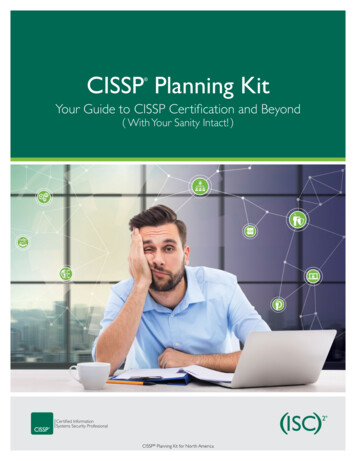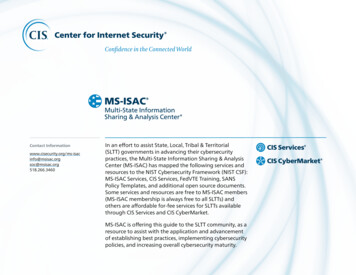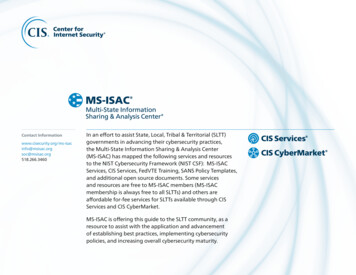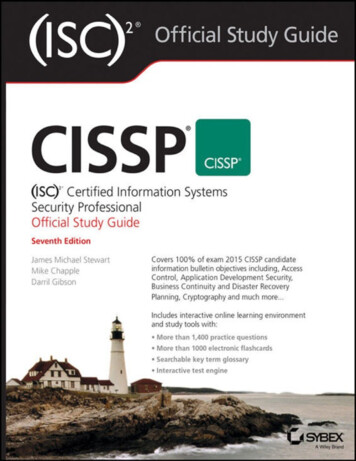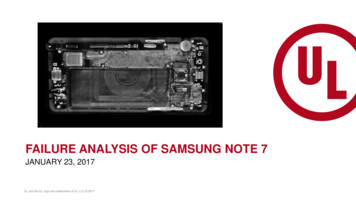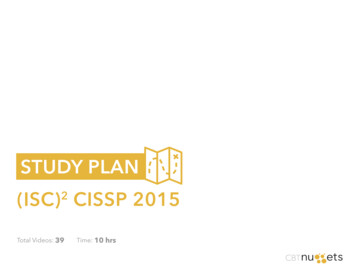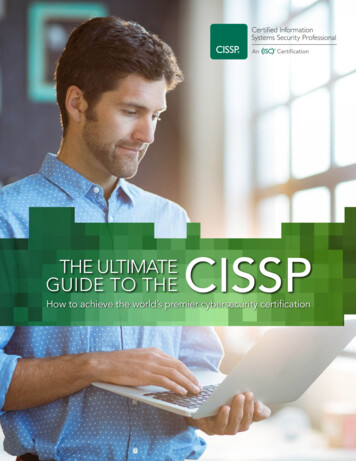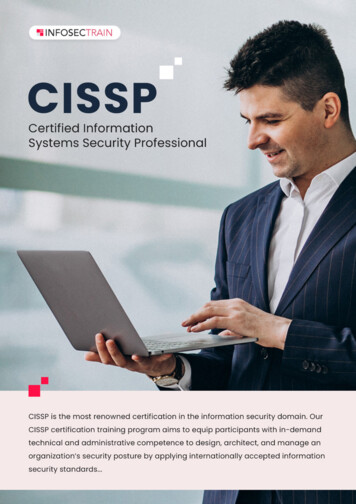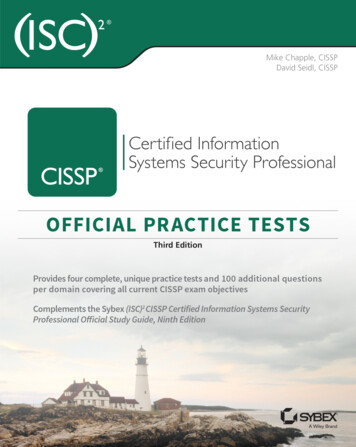
Transcription
(ISC)2 CISSP Certified InformationSystems Security ProfessionalOfficial Practice TestsThird Edition
(ISC)2 CISSP Certified InformationSystems Security ProfessionalOfficial Practice TestsThird EditionMike Chapple, CISSPDavid Seidl, CISSP
Copyright 2021 by John Wiley & Sons, Inc. All rights reservedPublished by John Wiley & Sons, Inc., Hoboken, New JerseyPublished simultaneously in Canada and the United KingdomISBN: 978-1-119-78763-1ISBN: 978-1-119-79315-1 (ebk.)ISBN: 978-1-119-78764-8 (ebk.)No part of this publication may be reproduced, stored in a retrieval system or transmitted in any form or by anymeans, electronic, mechanical, photocopying, recording, scanning or otherwise, except as permitted under Sections107 or 108 of the 1976 United States Copyright Act, without either the prior written permission of the Publisher, orauthorization through payment of the appropriate per-copy fee to the Copyright Clearance Center, 222 RosewoodDrive, Danvers, MA 01923, (978) 750-8400, fax (978) 646-8600. Requests to the Publisher for permission shouldbe addressed to the Permissions Department, John Wiley & Sons, Inc., 111 River Street, Hoboken, NJ 07030, (201)748-6011, fax (201) 748-6008, or online at www.wiley.com/go/permissions.Limit of Liability/Disclaimer of Warranty: While the publisher and author have used their best efforts in preparingthis book, they make no representations or warranties with respect to the accuracy or completeness of the contentsof this book and specifically disclaim any implied warranties of merchantability or fitness for a particular purpose.No warranty may be created or extended by sales representatives or written sales materials. The advice andstrategies contained herein may not be suitable for your situation. You should consult with a professional whereappropriate. Neither the publisher nor author shall be liable for any loss of profit or any other commercial damages,including but not limited to special, incidental, consequential, or other damages.For general information on our other products and services or to obtain technical support, please contact ourCustomer Care Department within the U.S. at (877) 762-2974, outside the U.S. at (317) 572-3993 or fax (317)572-4002.Wiley also publishes its books in a variety of electronic formats. Some content that appears in print may not beavailable in electronic formats. For more information about Wiley products, visit our web site at www.wiley.com.Library of Congress Control Number: 2021935480TRADEMARKS: WILEY and the Wiley logo are trademarks or registered trademarks of John Wiley & Sons, Inc.and/or its affiliates, in the United States and other countries, and may not be used without written permission. (ISC)2and CISSP are registered trademarks of International Information Systems Security Certification Consortium, Inc.All other trademarks are the property of their respective owners. John Wiley & Sons, Inc. is not associated with anyproduct or vendor mentioned in this book.Cover image(s): Getty Images Inc./Jeremy WoodhouseCover design: Wiley
AcknowledgmentsThe authors would like to thank the many people who made this book possible. Jim Minatelat Wiley Publishing helped us extend the Sybex CISSP franchise to include this title and hascontinued to champion with the International Information Systems Security CertificationConsortium (ISC)2. Carole Jelen, our agent, tackles all the back-end magic for our writingefforts and worked on both the logistical details and the business side of the book with herusual grace and commitment to excellence. Ben Malisow and Jerry Rayome, our technicaleditors, pointed out many opportunities to improve our work and deliver a high-qualityfinal product. Caroline Define served as our project manager and made sure everything fittogether. Many other people we’ll never meet worked behind the scenes to make this booka success, and we really appreciate their time and talents to make this next edition cometogether.
About the AuthorsMike Chapple, PhD, CISSP, is an author of the best-selling CISSP (ISC)2 CertifiedInformation Systems Security Professional Official Study Guide (Sybex, 2021), now in itsninth edition. He is an information security professional with two decades of experience inhigher education, the private sector, and government.Mike currently serves as Teaching Professor of IT, Analytics, and Operations at theUniversity of Notre Dame’s Mendoza College of Business. He previously served as SeniorDirector for IT Service Delivery at Notre Dame, where he oversaw the information security, data governance, IT architecture, project management, strategic planning, and productmanagement functions for the university.Before returning to Notre Dame, Mike served as Executive Vice President and ChiefInformation Officer of the Brand Institute, a Miami-based marketing consultancy. Mike alsospent four years in the information security research group at the National Security Agencyand served as an active duty intelligence officer in the U.S. Air Force.He is a technical editor for Information Security Magazine and has written 20 books,including Cyberwarfare: Information Operations in a Connected World (Jones & Bartlett,2015), CompTIA Security Training Kit (Microsoft Press, 2013), and CompTIA Cybersecurity Analyst (CySA ) Study Guide (Wiley, 2017) and Practice Tests (Wiley, 2018).Mike earned both his BS and PhD degrees from Notre Dame in computer science andengineering. He also holds an MS in computer science from the University of Idaho and anMBA from Auburn University. His IT certifications include the CISSP, Security , CySA ,CISA, PenTest , CIPP/US, CISM, CCSP, and PMP credentials.Mike provides books, video-based training, and free study groups for a wide variety of ITcertifications at his website, CertMike.com.David Seidl, CISSP, is Vice President for Information Technology and CIO at Miami University. During his IT career, he has served in a variety of technical and information securityroles including serving at the Senior Director for Campus Technology Services at the University of Notre Dame where he co-led Notre Dame’s move to the cloud, and oversaw cloudoperations, ERP, databases, identity management, and a broad range of other technologiesand service. He also served as Notre Dame’s Director of Information Security and led NotreDame’s information security program. He has taught information security and networkingundergraduate courses as an instructor for Notre Dame’s Mendoza College of Business andhas written books on security certification and cyberwarfare, including co-authoring theprevious editions of CISSP (ISC)2 Official Practice Tests (Sybex 2018) as well as CompTIACySA Study Guide: Exam CS0-002, CompTIA CySA Practice Tests: Exam CS0-002,CompTIA Security Study Guide: Exam SY0-601, and CompTIA Security Practice Tests:Exam SY0-601 as well as other certification guides and books on information security.David holds a bachelor’s degree in communication technology and a master’s degree ininformation security from Eastern Michigan University, as well as CISSP, CySA , Pentest ,GPEN, and GCIH certifications.
About the Technical EditorsBen Malisow is a consultant and writer with more than 25 years of experience in the fieldsof information, security, and information security. He teaches SSCP, CISSP, and CCSP preparation courses for (ISC)2 and has written the Official (ISC)2 CCSP Study Guide and the Official (ISC)2 Practice Tests books, among other titles; his latest works include CCSK PracticeTests and Exposed: How Revealing Your Data and Eliminating Privacy Increases Trust andLiberates Humanity. He and his partner Robin Cabe host the weekly podcast, “TheSensuous Sounds of INFOSEC,” from his website www.securityzed.com.Jerry Rayome, BS/MS Computer Science, CISSP, employed as a member of the CyberSecurity Program at Lawrence Livermore National Laboratory for over 20 years providingcyber security services that include software development, penetrative testing, incidentresponse, firewall implementation/administration, firewall auditing, honey net deployment/monitoring, cyber forensic investigations, NIST 900-53 control implementation/assessment,cloud risk assessment, and cloud security auditing.
Contents at a GlanceIntroductionxvChapter 1Security and Risk Management (Domain 1)Chapter 2Asset Security (Domain 2)25Chapter 3Security Architecture and Engineering (Domain 3)49Chapter 4Communication and Network Security (Domain 4)73Chapter 5Identity and Access Management (Domain 5)97Chapter 6Security Assessment and Testing (Domain 6)121Chapter 7Security Operations (Domain 7)145Chapter 8Software Development Security (Domain 8)169Chapter 9Practice Test 1195Chapter 10Practice Test 2225Chapter 11Practice Test 3253Chapter 12Practice Test 4283AppendixAnswers311Index1457
ContentsIntroductionxvChapter1Security and Risk Management (Domain 1)Chapter2Asset Security (Domain 2)25Chapter3Security Architecture and Engineering (Domain 3)49Chapter4Communication and Network Security (Domain 4)73Chapter5Identity and Access Management (Domain 5)97Chapter6Security Assessment and Testing (Domain 6)121Chapter7Security Operations (Domain 7)145Chapter8Software Development Security (Domain 8)169Chapter9Practice Test 1195Chapter10Practice Test 2225Chapter11Practice Test 3253Chapter12Practice Test 4283Answers311Chapter 1: Security and Risk Management (Domain 1)Chapter 2: Asset Security (Domain 2)Chapter 3: Security Architecture and Engineering (Domain 3)Chapter 4: Communication and Network Security (Domain 4)Chapter 5: Identity and Access Management (Domain 5)Chapter 6: Security Assessment and Testing (Domain 6)Chapter 7: Security Operations (Domain 7)Chapter 8: Software Development Security (Domain 8)Chapter 9: Practice Test 1Chapter 10: Practice Test 2Chapter 11: Practice Test 3Chapter 12: Practice Test 1457
Introduction(ISC)2 CISSP Certified Information Systems Security Professional Official Practice Testsis a companion volume to (ISC)2 CISSP Certified Information Systems Security ProfessionalOfficial Study Guide. It includes questions that cover content from the CISSP DetailedContent Outline and exam that became effective on May 1, 2021. If you’re looking to testyour knowledge before you take the CISSP exam, this book will help you by providing morethan 1,300 questions that cover the CISSP Common Body of Knowledge and easy-to-understand explanations of both right and wrong answers.If you’re just starting to prepare for the CISSP exam, we highly recommend that you use(ISC)2 CISSP Certified Information Systems Security Professional Official Study Guide tohelp you learn about each of the domains covered by the CISSP exam. Once you’re ready totest your knowledge, use this book to help find places where you may need to study more orto practice for the exam itself.Since this is a companion to CISSP Study Guide, this book is designed to be similar totaking the CISSP exam. It contains multipart scenarios as well as standard multiple-choiceand matching questions similar to those you may encounter on the certification exam. Thebook is broken up into 12 chapters: 8 domain-centric chapters with 100 or more questionsabout each domain, and 4 chapters that contain 125-question practice tests to simulate taking the exam.CISSP CertificationThe CISSP certification is offered by the International Information System SecurityCertification Consortium, or (ISC)2, a global nonprofit organization. The mission of (ISC)2is to support and provide members and constituents with credentials, resources, and leadership to address cyber, information, software, and infrastructure security to deliver value tosociety. (ISC)2 achieves this mission by delivering the world’s leading information securitycertification program, the CISSP. (ISC)2 also offered five additional certifications including:(ISC)2 also offered five additional certifications including: Systems Security Certified Practitioner (SSCP) Certified Authorization Professional (CAP) Certified Secure Software Lifecycle Professional (CSSLP) HealthCare Information Security and Privacy Practitioner (HCISPP) Certified Cloud Security Professional (CSP)
xviIntroductionThere are also three advanced CISSP certifications for those who want to move on fromthe base credential to demonstrate advanced expertise in a domain of information security. Information Systems Security Architecture Professional (CISSP-ISSAP) Information Systems Security Engineering Professional (CISSP-ISSEP) Information Systems Security Management Professional (CISSP-ISSMP)The CISSP certification covers eight domains of information security knowledge. Thesedomains are meant to serve as the broad knowledge foundation required to succeed in theinformation security profession. Security and Risk Management Asset Security Security Architecture and Engineering Communication and Network Security Identity and Access Management (IAM) Security Assessment and Testing Security Operations Software Development SecurityThe CISSP domains are periodically updated by (ISC)2. The most recent revision May 1,2021 slightly modified the weighting for Communication and Network security from 14percent to 13 percent while increasing the focus on Software Development Security from10 percent to 11 percent. It also added or expanded coverage of topics such as the datamanagement lifecycle, microservices, containerization, serverless computing, quantum computing, 5G networking, and modern security controls.Complete details on the CISSP Common Body of Knowledge (CBK) are contained in theExam Outline. It includes a full outline of exam topics, can be found on the (ISC)2 website atwww.isc2.org.Taking the CISSP ExamThe English version of the CISSP exam uses a technology called computer adaptive testing(CAT). With this format, you will face an exam containing between 100 to 150 questionswith a three-hour time limit. You will not have the opportunity to skip back and forthbecause the computer selects the next questions that it asks you based upon your answersto previous questions. If you’re doing well on the exam, it will get more difficult as youprogress. Don’t let that unnerve you!Other versions of the exam in French, German, Brazilian Portuguese, Spanish, Japanese,Simplified Chinese, and Korean use a traditional linear format. The linear format exam
Introductionxviiincludes 250 questions with a six-hour time limit. For either version of the exam, passingrequires achieving a score of at least 700 out of 1,000 points. It’s important to understandthat this is a scaled score, meaning that not every question is worth the same number ofpoints. Questions of differing difficulty may factor into your score more or less heavily, andadaptive exams adjust to the test taker.That said, as you work through these practice exams, you might want to use 70 percentas a goal to help you get a sense of whether you’re ready to sit for the actual exam. Whenyou’re ready, you can schedule an exam at a location near you through the (ISC)2 website.Questions on the CISSP exam are provided in both multiple-choice form and what (ISC)2calls advanced innovative questions, which are drag-and-drop and hotspot questions, both ofwhich are offered in computer-based testing environments. Innovative questions are scoredthe same as traditional multiple-choice questions and have only one right answer.(ISC)² exam policies are subject to change. Please be sure to check isc2.orgfor the current policies before you register and take the exam.Computer-Based Testing EnvironmentCISSP exams are now administered in a computer-based testing (CBT) format. You’ll registerfor the exam through the Pearson Vue website and may take the exam in the language ofyour choice. It is offered in English, French, German, Portuguese, Spanish, Japanese, Simplified Chinese, Korean, and a visually impaired format.You’ll take the exam in a computer-based testing center located near your home or office.The centers administer many different exams, so you may find yourself sitting in the sameroom as a student taking a school entrance examination and a healthcare professional earning a medical certification. If you’d like to become more familiar with the testing environment, the Pearson Vue website offers a virtual tour of a testing essional-Center-Tour.aspxWhen you take the exam, you’ll be seated at a computer that has the exam softwarealready loaded and running. It’s a pretty straightforward interface that allows you to navigate through the exam. You can download a practice exam and tutorial from the PearsonVue website.http://www.vue.com/athena/athena.aspAt the time this book went to press, (ISC)2 was conducting a pilot testof at-home computer-based exams for CISSP candidates in the UnitedStates. It is possible that this pilot will be extended to a permanent product and may become available in additional countries. Check the (ISC)2website for more information.
xviiiIntroductionExam Retake PolicyIf you don’t pass the CISSP exam, you shouldn’t panic. Many individuals don’t reach the baron their first attempt, but gain valuable experience that helps them succeed the second timearound. When you retake the exam, you’ll have the benefit of familiarity with the CBT environment and CISSP exam format. You’ll also have time to study the areas where you felt lessconfident.After your first exam attempt, you must wait 30 days before retaking the computer-basedexam. If you’re not successful on that attempt, you may re-test after 60 days. If you don't passafter your third attempt, you can re-test after 90 days for that and any subsequent attempts.You can’t take the test more than 4 times within a single calendar year. You can obtain moreinformation about (ISC)2 and its other certifications from its website at www.isc2.org.Work Experience RequirementCandidates who want to earn the CISSP credential must not only pass the exam but alsodemonstrate that they have at least five years of work experience in the information securityfield. Your work experience must cover activities in at least two of the eight domains of theCISSP program and must be paid, full-time employment. Volunteer experiences or part-timeduties are not acceptable to meet the CISSP experience requirement.You may be eligible to waive one of the five years of the work experience requirementbased upon your educational achievements. If you hold a bachelor’s degree or four-yearequivalent, you may be eligible for a degree waiver that covers one of those years. Similarly,if you hold one of the information security certifications on the current (ISC)2 credentialwaiver list (www.isc2.org/credential waiver/default.aspx), you may also waive ayear of the experience requirement. You may not combine these two programs. Holders ofboth a certification and an undergraduate degree must still demonstrate at least four years ofexperience.If you haven’t yet completed your work experience requirement, you may still attempt theCISSP exam. Individuals who pass the exam are designated Associates of (ISC)2 and have sixyears to complete the work experience requirement.Recertification RequirementsOnce you’ve earned your CISSP credential, you’ll need to maintain your certification bypaying maintenance fees and participating in continuing professional education (CPE). Aslong as you maintain your certification in good standing, you will not need to retake theCISSP exam.
IntroductionxixCurrently, the annual maintenance fees for the CISSP credential are 125 per year. Thisfee covers the renewal for all (ISC)2 certifications held by an individual.The CISSP CPE requirement mandates earning at least 120 CPE credits during each threeyear renewal cycle. Associates of (ISC)2 must earn at least 15 CPE credits each year. (ISC)2provides an online portal where certificate holders may submit CPE completion for reviewand approval. The portal also tracks annual maintenance fee payments and progress towardrecertification.Using This Book to PracticeThis book is composed of 12 chapters. Each of the first eight chapters covers a domain, witha variety of questions that can help you test your knowledge of real-world, scenario, andbest-practice security knowledge. The final four chapters are complete practice exams thatcan serve as timed practice tests to help determine whether you’re ready for the CISSP exam.We recommend taking the first practice exam to help identify where you may need tospend more study time and then using the domain-specific chapters to test your domainknowledge where it is weak. Once you’re ready, take the other practice exams to make sureyou’ve covered all the material and are ready to attempt the CISSP exam.Using the Online Practice TestsAll the questions in this book are also available in Sybex’s online practice test tool. To getaccess to this online format, go to www.wiley.com/go/sybextestprep and start by registeringyour book. You’ll receive a PIN code and instructions on where to create an online test bankaccount. Once you have access, you can use the online version to create your own sets ofpractice tests from the book questions and practice in a timed and graded setting.
Chapter1Security and RiskManagement(Domain 1)SUBDOMAINS1.1Understand, adhere to, and promote professional ethics1.2Understand and apply security concepts1.3Evaluate and apply security governance principles1.4Determine compliance and other requirements1.5 Understand legal and regulatory issues that pertain toinformation security in a holistic context1.6 Understand requirements for investigation types (i.e.,administrative, criminal, civil, regulatory, industrystandards)1.7 Develop, document, and implement security policy,standards, procedures, and guidelines1.8 Identify, analyze, and prioritize Business Continuity (BC)requirements1.9 Contribute to and enforce personnel security policies andprocedures1.10Understand and apply risk management concepts1.11 Understand and apply threat modeling concepts andmethodologies1.12 Apply Supply Chain Risk Management (SCRM) concepts1.13 Establish and maintain a security awareness, education,and training program
Chapter 121.2.3.4.5. Security and Risk Management (Domain 1)Alyssa is responsible for her organization’s security awareness program. She is concerned thatchanges in technology may make the content outdated. What control can she put in place toprotect against this risk?A.GamificationB.Computer-based trainingC.Content reviewsD.Live trainingGavin is creating a report to management on the results of his most recent risk assessment.In his report, he would like to identify the remaining level of risk to the organization afteradopting security controls. What term best describes this current level of risk?A.Inherent riskB.Residual riskC.Control riskD.Mitigated riskFrancine is a security specialist for an online service provider in the United States. Sherecently received a claim from a copyright holder that a user is storing information on herservice that violates the third party’s copyright. What law governs the actions that Francinemust take?A.Copyright ActB.Lanham ActC.Digital Millennium Copyright ActD.Gramm Leach Bliley ActFlyAway Travel has offices in both the European Union (EU) and the United States andtransfers personal information between those offices regularly. They have recently received arequest from an EU customer requesting that their account be terminated. Under the GeneralData Protection Regulation (GDPR), which requirement for processing personal informationstates that individuals may request that their data no longer be disseminated or processed?A.The right to accessB.Privacy by designC.The right to be forgottenD.The right of data portabilityAfter conducting a qualitative risk assessment of her organization, Sally recommendspurchasing cybersecurity breach insurance. What type of risk response behavior is sherecommending?A.AcceptB.TransferC.ReduceD.Reject
Chapter 16.7.8.9. Security and Risk Management (Domain 1)3Which one of the following elements of information is not considered personally identifiableinformation that would trigger most United States (U.S.) state data breach laws?A.Student identification numberB.Social Security numberC.Driver’s license numberD.Credit card numberRenee is speaking to her board of directors about their responsibilities to review cybersecurity controls. What rule requires that senior executives take personal responsibility forinformation security matters?A.Due diligence ruleB.Personal liability ruleC.Prudent man ruleD.Due process ruleHenry recently assisted one of his co-workers in preparing for the CISSP exam. During thisprocess, Henry disclosed confidential information about the content of the exam, in violationof Canon IV of the Code of Ethics: “Advance and protect the profession.” Who may bringethics charges against Henry for this violation?A.Anyone may bring charges.B.Any certified or licensed professional may bring charges.C.Only Henry’s employer may bring charges.D.Only the affected employee may bring charges.Wanda is working with one of her organization’s European Union business partners to facilitate the exchange of customer information. Wanda’s organization is located in the UnitedStates. What would be the best method for Wanda to use to ensure GDPR compliance?A.Binding corporate rulesB.Privacy ShieldC.Standard contractual clausesD.Safe harbor10. Yolanda is the chief privacy officer for a financial institution and is researching privacyrequirements related to customer checking accounts. Which one of the following laws is mostlikely to apply to this situation?A.GLBAB.SOXC.HIPAAD.FERPA
Chapter 14 Security and Risk Management (Domain 1)11. Tim’s organization recently received a contract to conduct sponsored research as agovernment contractor. What law now likely applies to the information systems involvedin this contract?A.FISMAB.PCI DSSC.HIPAAD.GISRA12. Chris is advising travelers from his organization who will be visiting many different countriesoverseas. He is concerned about compliance with export control laws. Which of the following technologies is most likely to trigger these regulations?A.Memory chipsB.Office productivity applicationsC.Hard drivesD.Encryption software13. Bobbi is investigating a security incident and discovers that an attacker began with a normaluser account but managed to exploit a system vulnerability to provide that account withadministrative rights. What type of attack took place under the STRIDE threat n of privilege14. You are completing your business continuity planning effort and have decided that you wantto accept one of the risks. What should you do next?A.Implement new security controls to reduce the risk level.B.Design a disaster recovery plan.C.Repeat the business impact assessment.D.Document your decision-making process.15. You are completing a review of the controls used to protect a media storage facility in yourorganization and would like to properly categorize each control that is currently in place.Which of the following control categories accurately describe a fence around a facility?(Select all that e
Chapter 1 Security and Risk Management (Domain 1)516. Tony is developing a business continuity plan and is having difficulty prioritizing resourcesbecause of the difficulty of combining information about tangible and intangible assets. Whatwould be the most effective risk assessment approach for him to use?A.Quantitative risk assessmentB.Qualitative risk assessmentC.Neither quantitative nor qualitative risk assessmentD.Combination of quantitative and qualitative risk assessment17. Vincent believes that a former employee took trade secret information from his firm andbrought it with him to a competitor. He wants to pursue legal action. Under what law couldhe pursue charges?A.Copyright lawB.Lanham ActC.Glass-Steagall ActD.Economic Espionage Act18. Which one of the following principles imposes a standard of care upon an individual thatis broad and equivalent to what one would expect from a reasonable person under the circumstances?A.Due diligenceB.Separation of dutiesC.Due careD.Least privilege19. Brenda’s organization recently completed the acquisition of a competitor firm. Which oneof the following tasks would be LEAST likely to be part of the organizational processesaddressed during the acquisition?A.Consolidation of security functionsB.Integration of security toolsC.Protection of intellectual propertyD.Documentation of security policies20. Kelly believes that an employee engaged in the unauthorized use of computing resources fora side business. After consulting with management, she decides to launch an administrativeinvestigation. What is the burden of proof that she must meet in this investigation?A.Preponderance of the evidenceB.Beyond a reasonable doubtC.Beyond the shadow of a doubtD.There is no standard
Chapter 16 Security and Risk Management (Domain 1)21. Keenan Systems recently developed a new manufacturing process for microprocessors. Thecompany wants to license the technology to other companies for use but wants to preventunauthorized use of the technology. What type of intellectual property protection is bestsuited for this situation?A.PatentB.Trade secretC.CopyrightD.Trademark22. Which one of the following actions might be taken as part of a business continuity plan?A.Restoring from backup tapesB.Implementing RAIDC.Relocating to a cold siteD.Restarting business operations23. When developing a business impact analysis, the team should first create a list of assets. Whatshould happen next?A.Identify vulnerabilities in each asset.B.Determine the risks facing the asset.C.Develop a value for each asset.D.Identify threats facing each asset.24. Mike rec
Mike Chapple, PhD, CISSP, is an author of the best-selling CISSP (ISC)2 Certified Information Systems Security Professional Official Study Guide (Sybex, 2021), now in its ninth edition. He is an information security professional with two decades of experience in higher education, the private sector, and government.
